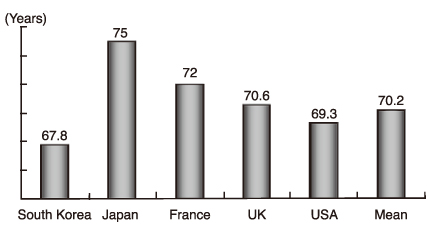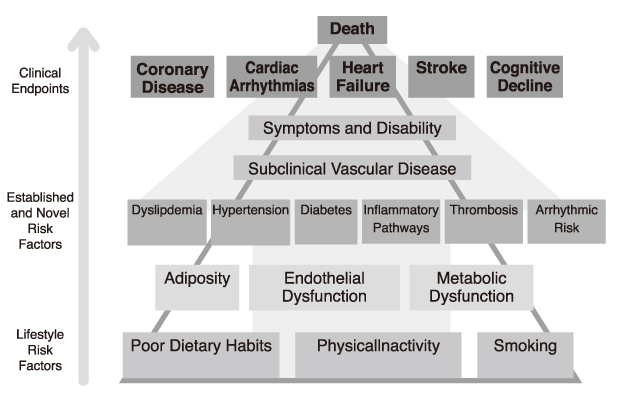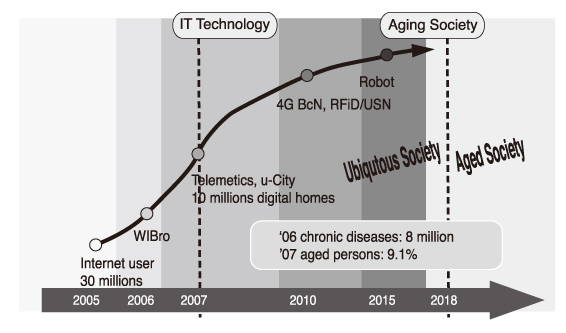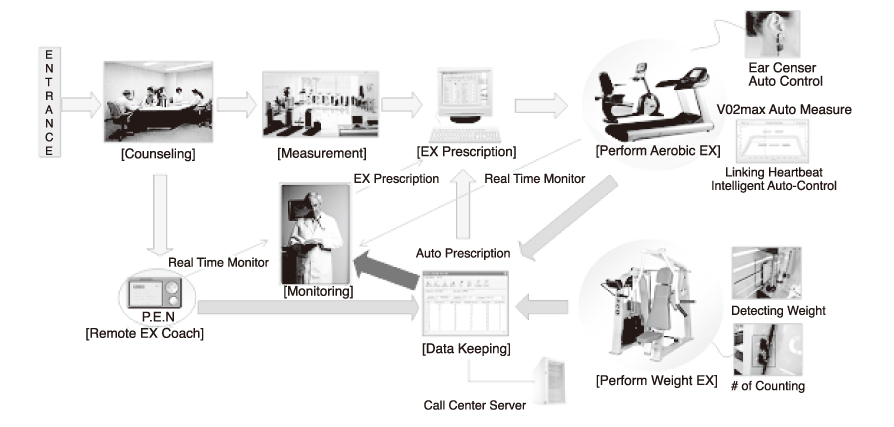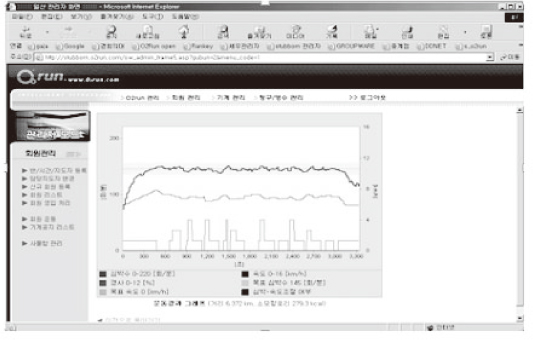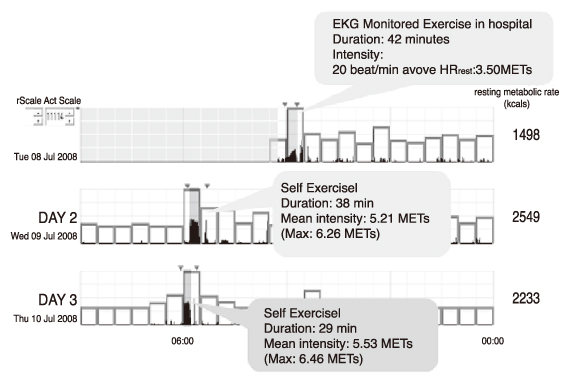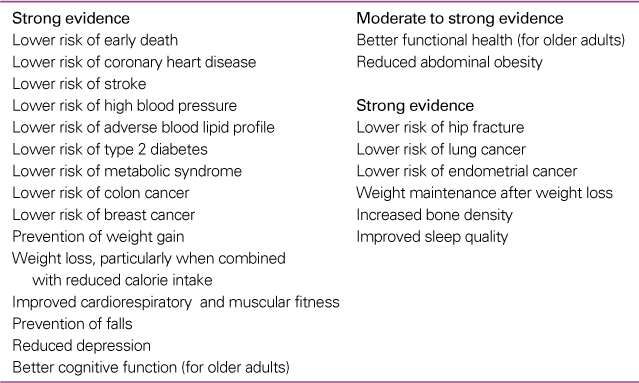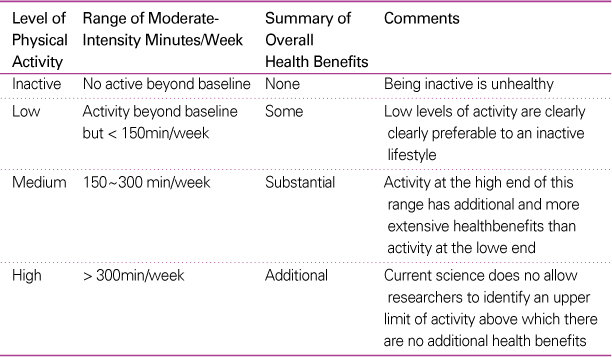 |
 |
- Search
| J Korean Med Assoc > Volume 52(12); 2009 > Article |
Abstract
Recently, the aging society is facing with the rapid increase of chronic diseases. Despite the advanced medical technology, chronic diseases have not comprehensively managed yet. In the modern society, many people have to spend their extended life span suffering from chronic diseases and disabilities, and also a huge medical cost has emerged as a serious social problem. With IT improvement, u-health system has been developed to link home and medical service systems by arranging medical data, decision making and medical guidelines for various situations. It can promote the therapeutic compliance for the patients with chronic diseases. And also for the medical service providers, it can provide useful data to make an accurate medical decision. As we know, the chronic disease is caused by inactivity and the management of chronic disease requires the modification of inactive life style. U-health medical fitness system can not only prescribe proper activity to control the chronic disease but also it can monitor the patients' physical activity in everyday life. By the successful management of chronic diseases based on u-health system, we want to achieve the expansion of disease-free and disability-free life expectancy and a solution to reduce the burden of medical expenses in modern society eventually.
References
1. World Health Organization. Reducing risks, promoting healthy life. World Health Report 2002 2002;Geneva: World Health Organization.
2. Morris JN. Exercise in the prevention of coronary heart disease: today's best buy in public health. Med Sci Sports Exerc 1994;26:807-814.
14. Halbert JA, Silagy CA, Finucane P, Withers RT, Hamdorf PA, Andrews GR. The effectiveness of exercise training in lowering blood pressure: a meta-analysis of randomised controlled trials of 4 weeks or longer. Journal of human hypertension 1997;11:641-649.
5. Heath GW, Wilson RH, Smith J. Community-based exercise and weight control: Diabetes risk reduction and glycemic control in Zuni Indians. Am J Clin Nutr 1991;53:S1642-S1646.
6. Krotkiewski M, Lonnroth P, Mondroukas K. Effects of physical training on insulin secretion and effectiveness and on glucose metabolism in obesity and type II (non-insulin-dependent) diabetes mellitus. Diabetologia 1985;28:881-881.
7. Saltin B, Lindgarde F, Lithell H. Metabolic effects of long-term physical training in maturity-onset diabetes. Excerpta Med Amsterdam 1980;9:345-350.
8. Schneider SH, Khachadurian AK, Amorosa LF. Ten-year experience with an exercise-based outpatient lifestyle modification program in the treatment of diabetes mellitus. Diabetes Care 1992;15:1800-1810.
9. Horton ES. In: Lebovitz HE, editor. Exercise. Therapy for Diabetes Mellitus and Related Disorders 1998;Canada: American Diabetes Association. 150-159.
10. Heath H III, Melton LJ III, Chu CP. Diabetes mellitus and risk of skeletal fracture. N Engl J Med 1980;303:567-570.
11. American Diabetes Association. Diabetes mellitus and exercise (position statement). Diabetes Care 2001;23:S51-S55.
12. American College of Sports Medicine. Exercise and type 2 diabetes (position stand). Medicine and Science in Sports and Exercise 2000;32:1345-1360.
13. Kohl HW, Gordon NF, Villegas JA. Cardiorespiratory fitness, glycemic status, and mortality risk in men. Diabetes Care 1992;15:184-192.
14. King AC, Tribble DL. The role of exercise in weight regulation in non-athletes. Sports Medicine 1991;11:331-349.
15. Wing RR, Epstein LH, Paternostro-Bayles M. Exercise in a behavioral weight control programme for obese patients with type 2 (non-insulin-dependent) diabetes. Diabetologia 1988;31:902-909.
16. Hagberg JM, Montain ST, Martin WH. Effect of exercise training in 60- to 69-year-old persons with essential hypertension. Am J Cardiol 1989;64:348-353.
17. Krotkiewski M, Mandroukas K, Sjostrom L. Effects of long-term physical training on body fat, metabolism, and blood pressure in obesity. Metabolism 1979;28:650-658.
18. Rocchini AP, Katch U, Schork A. Insulin and blood pressure during weight loss in obese adolescents. Hypertension 1987;10:267-273.
19. Schneider SH, Vitug A, Ruderman NB. Atherosclerosis and physical activity. Diabetes Metab Rev 1986;1:445-481.
20. Hamiton AL, Killian KJ, Summer E, jones NL. Symptom intensity and subjective limitation to exercise in patinets with cardiorespiratory disoders. Chest 1996;110:1255-1263.
21. Trooster T, Gosselink R, Decramer M. Short and Long-term effects of outpatient rehabilitation in patients with COPD; a randomized trial. Am J Med 2000;109:207-212.
22. Finnerty JP, Keeping I, Bullough I, Jones J. The effectiveness of outpatient pulmonary rehabilitation in chronic lung disease; a randomized controlled trial. Chest 2001;119:1705-1710.
23. Young P, Dewse M, Fergusson W, Kolbe J. Improvements in outcomes for COPD attributable to a hospital-based respiratory rehabilitation programme. Aust N A Med 1999;29:59-65.
24. Parker L, Walker J. Effects of a pulmonary rehabilitation program on physiologic measures, quality of life and resource utilization in a health maintenance organization setting. Respiratory Care 1998;43:177-182.
25. Belman MJ, Kendregan BA. Exercise training fails to increase skeletal muscle enzymes in patients with COPD. Am Rev Respir Dis 1981;123:256-261.
26. Lorig KR, Bodenheimer T, Holman H, Grumbach K. Patient self-management of chronic disease in primary care. JAMA 2002;288:2469-2475.
27. Lorig K, Holman H. Self-management education: context, definition, and outcomes and mechanisms. Proceedings of the 1st Chronic Disease Self-Management Conference accessed Jul 2003. August 2000. Sydney Australia: www.chronicdisease.health.gov.au/pdfs/lorig.pdf
28. Lorig KR, Sobel DS, Stewart AL, Brown BW Jr, Bandura A, Ritter P, Gonzalez VM, Laurent DD, Holman HR. Evidence suggesting that a chronic disease self-management program can improve health status while reducing utilization and costs: a rando-mized trial. Med Care 1999;37:5-14.
29. Battersby M, Reece M, Collins J. Chronic disease self-management education-an Australian experience. Procee-dings of the 1st Chronic Disease Self-Management Confe-rence accessed Jul 2003. August 2000. Sydney, Australia: www.chronicdisease.health.gov.au/pdfs/battersby.pdf
30. Lorig KR, Ritter P, Stewart AL, Sobel DS, Brown BW Jr, Bandura A, Gonzalez VM, Laurent DD, Holman HR. Chronic disease self-manage-ment program - 2 year health status and health care utilisation outcomes. Med Care 2001;39:1217-1223.
31. Kinsella A, Warner I. Telehealth and managing congestive heart failure. Caring 1998;17:14-18.
32. De Lusignan S, Wells S, Johnson P. Compliance and effectiveness of 1 year's home telemonitoring. The report of a pilot study of patients with chronic heart failure. Eur J Heart Fail 2001;3:723-730.
33. Steel S, Lock S, Johnson N. A feasibility study of remote monitoring of asthmatic patients. J Telemed Telecare 2002;8:290-296.
34. Tsang MW, Mok M, Kam G. Improvement in diabetes control with a monitoring system based on a hand-held, touch-screen electronic diary. J Telemed Telecare 2001;7:47-50.
35. Bondmass M, Bolger N, Castro G, Avitall B. The effect of home monitoring and telemanagement on blood pressure control among African Americans. Telemed J 2000;6:15-23.
36. Roine R, Ohinmaa A, Hailey D. Assessing telemedicine: a systematic review of the literature. CMAJ 2001;165:765-771.
37. Hersh W, Helfand M, Wallace J. A systematic review of the efficacy of telemedicine for making diagnostic and management decisions. J Telemed Telecare 2002;8:197-209.
38. Whitten P, Kingsley C, Grigsby J. Results of a meta-analysis of cost-benefits research: is this a question worth asking? J Telemed Telecare 2000;6:Suppl 1. S4-S6.
39. Johnston B, Wheeler L, Deuser J. Outcomes of the Kaiser Permanente Tele-Home Health Research Project. Arch Fam Med 2000;9:40-45.
40. Roglieri JL, Futterman R, McDonough KL. Disease management interventions to improve outcomes in congestive heart failure. Am J Manag Care 1997;3:1831-1839.
41. Jerant AF, Azari R, Nesbitt TS. Reducing the cost of frequent hospital admissions for congestive heart failure. Med Care 2001;39:1234-1245.
42. Park JH. Antihypertensive drug medication adherence of national health insurance beneficiaries and its affecting factors in Korea 2006.
43. Gangwon Provine Health Department. Public u-Health management guideline 2009.
44. Choi EH, Jun AY, Ahn MO, Ahn DS. Monitoring of home physical activities with calorimeter in phase II cardiac rehabilitation patients CJK Medical Informatics 2008;55-57.
- TOOLS
-
METRICS

-
Related articles in
J Korean Med Assoc -
Management of Common Disease in Pediatric Orthopedic Clinic2000 September;43(9)
Health Promotion Services and Chronic Disease Management and Preventive services2009 April;52(4)




